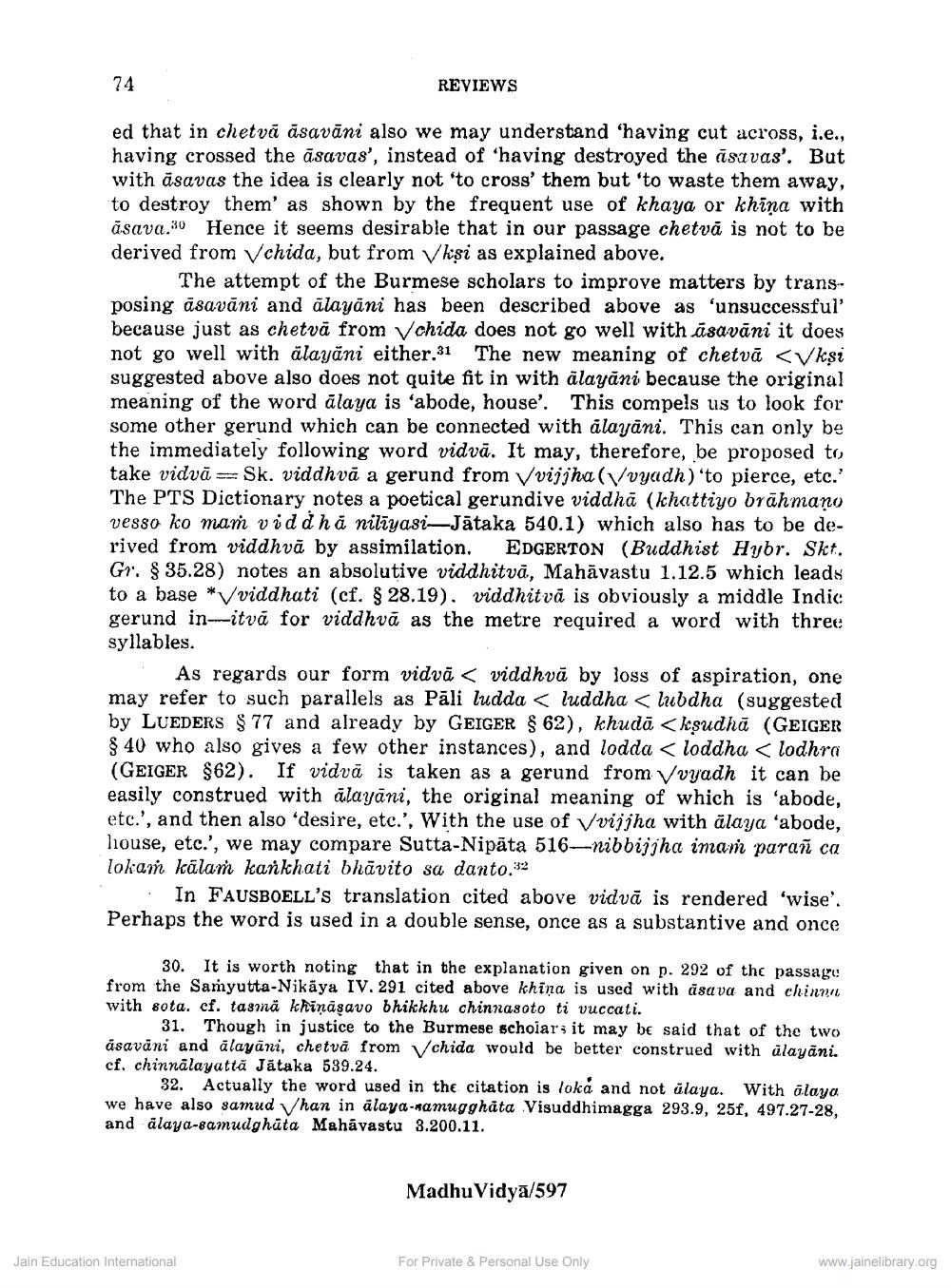________________
74
REVIEWS
ed that in chetvā āsavāni also we may understand having cut across, i.e., having crossed the āsavas', instead of 'having destroyed the asa vas'. But with a savas the idea is clearly not 'to cross' them but 'to waste them away, to destroy them' as shown by the frequent use of khaya or khina with āsava.30 Hence it seems desirable that in our passage chetvā is not to be derived from Vchida, but from Vkşi as explained above.
The attempt of the Burmese scholars to improve matters by transposing āsavāni and alayāni has been described above as 'unsuccessful' because just as chetvā from Vchida does not go well with āsavāni it does not go well with älayani either.31 The new meaning of chetvā <V kşi suggested above also does not quite fit in with alayāni because the original meaning of the word alaya is 'abode, house'. This compels us to look for some other gerund which can be connected with alayāni. This can only be the immediately following word vidvā. It may, therefore, be proposed to take vidvā=Sk. viddhvă a gerund from vijjha (Vvyadh) 'to pierce, etc.' The PTS Dictionary notes a poetical gerundive viddhā (khattiyo brāhmano vesso ko man viddha nilīyasi—Jātaka 540.1) which also has to be derived from viddhvă by assimilation. EDGERTON (Buddhist Hybr. Skt. Gr. $ 35.28) notes an absolutive viddhitvā, Mahāvastu 1.12.5 which leads to a base * viddhati (cf. § 28.19). viddhitvā is obviously a middle Indic gerund in-itvā for viddhvă as the metre required a word with three syllables.
As regards our form vidvā < viddhvä by loss of aspiration, one may refer to such parallels as Pāli ludda < luddha < lubdha (suggested by LUEDERS $77 and already by GEIGER 8 62), khudā <ksudhā (GEIGER $ 40 who also gives a few other instances), and lodda < loddha < lodhra (GEIGER 862). If vidvā is taken as a gerund from vyadh it can be easily construed with alayāni, the original meaning of which is 'abode, etc.', and then also desire, etc.', With the use of vijjha with älaya 'abode, louse, etc.', we may compare Sutta-Nipāta 516-nibbijjha inam parañ ca lokam kālam kankhati bhāvito sa danto.32
In FAUSBOELL'S translation cited above vidvā is rendered 'wise'. Perhaps the word is used in a double sense, once as a substantive and once
30. It is worth noting that in the explanation given on p. 292 of the passage! from the Samyutta-Nikāya IV. 291 cited above khina is used with ăsava and chinn with sota. cf. tasmã khinagavo bhikkhu chinnasoto ti vuccati.
31. Though in justice to the Burmese scholars it may be said that of the two asavāni and alayāni, chetvå from Vchida would be better construed with ülayāni. cf. chinnālayatta Jätaka 539.24.
32. Actually the word used in the citation is loka and not älaya. With ālaya. we have also samud han in alaya-ramugghåta Visuddhimagga 293.9, 25f, 497.27-28, and älaya-8amudghāta Mahāvastu 3.200.11.
Madhu Vidya/597
Jain Education International
For Private & Personal Use Only
www.jainelibrary.org




